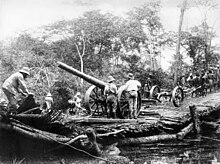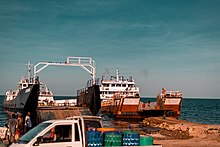Bagamoyo
The mediaeval settlement served as the destination for thousands of porters who travelled with the caravan and carried, on average, 70-pound loads across their shoulders, principally ivory tusks.
After a taxing journey and months of hiking over dangerous terrain, Bagamoyo appealed as a destination for recreation and rest.
Until the 18th century, Bagamoyo, the settlement 5 kilometres (3 mi) north of Kaole, was a small trading center where most of the population were fishermen and farmers.
[5] In the late 18th century, Muslim families settled in Bagamoyo, all of which were relatives of Shamvi la Magimba in Oman.
They made their living by enforcing taxes on the native population and by trading in salt, gathered from the Nunge coast north of Bagamoyo.
In the first half of the 19th century, Bagamoyo became a trading port for ivory and slave, with traders coming from the African interior – places as far as Morogoro, Lake Tanganyika and Usambara- on their way to Zanzibar.
[8][9] The slave trade in East Africa was officially prohibited in the year 1873, but continued surreptitiously to the end of the 19th century.
Originally the mission was intended to house children who were rescued from slavery, but it soon expanded to a church, a school, and some workshops and farming projects.
But Bagamoyo was not only a trade centre for ivory and copra; it was also a starting point for renowned European explorers.
Some of these were Richard Francis Burton, John Hanning Speke, Henry Morton Stanley[10]: 55 and James Augustus Grant.
When the German Empire decided to build a narrow gauge railway from Dar es Salaam into the interior in 1905, Bagamoyo's importance began to decline.
In the East African campaign of World War I, British and Empire forces attacked Bagamoyo in August 1916.
[12] A kite balloon flown by HMS Manica directed a naval bombardment of German positions ashore.
The Department of Antiquities in Tanzania is working to maintain the ruins of the colonial era in and around Bagamoyo and to revitalize the town.
[14] Its history and proximity to Dar es Salaam has led Bagamoyo to be more diverse than some other areas of the country.







